If you are not already a subscriber, you are welcome to enter your email address here to sign up to receive the Space History newsletter on a daily basis. Under no circumstances will we release your legitimate email address entered here to outside persons or organizations, and it will only be used for mailing the specific information you have requested.
| Enter your email address here: |
Unsubscribe instructions are included in every newsletter issue in case you decide you no longer wish to receive it.
Note: We record the IP address from which subscriptions are entered to help prevent SPAM abuses.
Race To Space
Someone will win the prize...
... but at what cost?
Visit RaceToSpaceProject.com
to find out more!
1531
Halley's Comet passed perihelion in its twenty-fourth known passage, as calculated from records including ones by Chinese astronomers.
In 2000 years of observations since 240 BCE, Chinese records have never missed a return of Halley's Comet. From those records, Cowell and Crommelin computed the dates of perihelion passage as:
1. 15 May 240 BCE
2. 20 May 163 BCE
3. 15 August 87 BCE
4. 8 October 12 BCE
5. 26 January 66 CE
6. 25 March 141 CE
7. 6 April 218 CE
8. 7 April 295 CE
9. 13 February 374 CE
10. 3 July 451 CE
11. 15 November 530 CE
12. 26 March 607 CE
13. 26 November 684 CE
14. 10 June 760 CE
15. 25 February 837 CE
16. 17 July 912 CE
17. 2 September 989 CE
18. 25 March 1066 CE
19. 19 April 1145 CE
20. 10 September 1222 CE
21. 22.7 October 1301 CE
22. 8.8 November 1378 CE
23. 8.2 January 1456 CE
24. 25.8 August 1531 CE
25. 26.9 October 1607 CE
26. 14.8 September 1682 CE
27. 12.6 March 1758 CE
28. 15.9 November 1835 CE
29. 19.7 April 1910 CE
30. 9 February 1986 CE
Note that the precision of the dates from passage 21 onward could be computed with increased accuracy because of additional observations. However, at the time of their computation, the 1986 passage was still a future event. (The actual date was found from other sources.)
On 19 April 607, Comet 1P/607 H1 (Halley) approached within 0.0898 AU (13.5 million km, 8.4 million miles) of Earth. On 374-April-1.9, it had approached closer, having come within 0.0884 AU (13.2 million km, 8.2 million miles), and on 837-April-10.5, it became the third closest approach in history prior to 1900, passing within 0.0334 AU (5 million km, 3.1 million miles).
On 16 October 1982, astronomers David Jewitt and G. Edward Danielson using a CCD camera with the 5.1 m Hale telescope at Mt. Palomar Observatory were the first to detect Halley's Comet on its thirtieth recorded return.
See also The past orbit of Halley's Comet (SAO/NASA ADS)
See also Comet Close Approaches prior to 1900 (CNEOS)
See also History of Halley's Comet (Wikipedia)
See also Halley's Comet (CQ Press)
See also Comet 1P/Halley (Halley's Comet) (Smithsonian NASM)
ref: adsabs.harvard.edu
1609
Galileo Galilei demonstrated his first telescope to Venetian lawmakers. (Gregorian calendar date, some reports indicate 21 August)
ref: www.theguardian.com
1819
Died, James Watt, Scottish engineer (steam engine improvements)
James Watt (19 January 1736 - 25 August 1819) was a Scottish mathematician and engineer whose improvements to the steam engine were a key stage in the Industrial Revolution.
He was born in Greenock, Scotland, and lived and worked in Birmingham, England. He was a key member of the Lunar Society. Many of his papers are now kept in the Birmingham Central Library.
ref: en.wikipedia.org
1822
Died, Sir William Herschel, astronomer
Sir William Herschel (15 November 1738 - 25 August 1822) was a German-born British astronomer and composer who became famous for discovering the planet Uranus, and made many other astronomical discoveries.
After starting as a musician, his interest in astronomy grew stronger after 1773, and he built some telescopes and made the acquaintance of Nevil Maskelyne. He observed the Moon, measuring the heights of Lunar mountains, and also worked on a catalog of double stars.
The turning point in his life was 13 March 1781, while residing at 19 New King Street, Bath, when he discovered Uranus. This made him famous and enabled him to turn to astronomy full-time. Naming the new planet Georgium Sidus in honour of King George III also brought him favour (although the name didn't stick). That same year, Herschel was awarded the Copley Medal and was elected a Fellow of the Royal Society. In 1782, he was appointed "The King's Astronomer" and he and his sister Caroline subsequently moved to Datchet (then in Buckinghamshire but now in Berkshire) on 1 August 1782. He continued his work as a telescope maker as well, selling a number of them to other astronomers.
He also discovered infrared radiation (c.1800) by passing sunlight through a prism and holding a thermometer just beyond the red end of the visible spectrum. The thermometer indicated a temperature increase and this led to Herschel's conclusion that there must be an invisible form of energy.
In his later career, Herschel discovered two satellites of Saturn, Mimas and Enceladus; and two satellites of Uranus, Titania and Oberon. He did not give the latter satellites their names; rather, they were named by his son John in 1847 and 1852, respectively, well after his death.
In addition to working on creating an extensive catalog of nebulae, he also continued to study double stars. He was the first to discover that most double stars are not mere optical doubles as had been supposed previously, but are true binary stars.
From studying the proper motion of stars, he was the first to realize that the solar system is moving through space, and he determined the approximate direction of that movement. He also studied the structure of the Milky Way and concluded that it was in the shape of a disk.
Herschel coined the word "asteroid".
Herschel was also known for an eccentric theory that the Sun was inhabited.
ref: en.wikipedia.org
1865
R. Luther discovered asteroid #84 Klio.
1867
Died, Michael Faraday, British physicist, chemist (electromagnetic theory)
Michael Faraday (22 September 1791 - 25 August 1867) was a British scientist (physicist and chemist) who made significant contributions in the study of electromagnetism and electrochemistry. His experiments also established the relationship between electricity, magnetism and light. Among his inventions are the homopolar motor, dynamo (a predecessor of modern generators), and the first form of the Bunsen burner.
ref: en.wikipedia.org
1889
C. H. F. Peters discovered asteroid #287 Nephthys.
1897
A. Charlois discovered asteroid #426 Hippo.
1900
Died, Friedrich Nietzsche, German philosopher
ref: en.wikipedia.org
1908
Born, Aleksandr Andreyevich Raspletin, Russian Chief Designer of KB-1 (1953-1967), contributed to the RORSAT, EORSAT, and ASAT programs
ref: encyclopedia2.thefreedictionary.com
1908
Died, Antoine Henri Becquerel, Nobel 1903 "in recognition of the extraordinary services he has rendered by his discovery of spontaneous radioactivity"
ref: www.nobelprize.org
1909
J. Palisa discovered asteroid #688 Melanie.
1912
The first well-documented case of a pilot successfully correcting and surviving a spin occurred when Royal Flying Corps Lieutenant Wilfred Parke turned his rudder against the direction of the spin.
ref: www.historynet.com
1916
G. Neujmin discovered asteroids #829 Academia and #830 Petropolitana.
1919
The first scheduled passenger service by airplane was inaugurated, between Paris and London.
ref: www.britishairways.com
1927
S. Belyavsk and N. Ivanov discovered asteroid #1086 Nata.
1930
E. Delporte discovered asteroid #1168 Brandia.
1932
Born, Anatoli Yakovlevich Kartashov (at Pervoy Sadovoye, Russia), cosmonaut candidate (Air Force Group 1 - 1960), left space service 7 April 1962 after being overstressed in centrifuge training
ref: www.spacefacts.de
1933
S. Arend discovered asteroids #1281 Jeanne, #1286 Banachiewicza and #1287 Lorcia; G. Neujmin discovered asteroid #1331 Solvejg; and K. Reinmuth discovered asteroid #2676 Aarhus and #2943.
1949
Using a partial pressure suit to save a pilot's life during high altitude flight first occurred during XS-1 rocket plane Flight 124 when the X-1 lost cockpit pressurization at about 69,000 ft (21 km). Pilot Frank Everest made a safe emergency descent.
ref: en.wikipedia.org
1960
Born, Lee Joseph Archambault (at Oak Park, Illinois, USA), Colonel USAF, NASA astronaut (STS 117, STS 119; nearly 26d 15.75h total time in spaceflight)

Astronaut Lee J. Archambault, STS-119 commander, NASA photo (13 May 2009)
Source: Wikipedia (spaceflight.nasa.gov killed 25 Feb 2021)
ref: www.nasa.gov
1961 19:26:00 GMT
NASA launched Explorer 13 (S 55A), designed in part to measure the effects of micrometeoroids on spaceflight, which ended up in a useless orbit and failed to meet expectations, thereby necessitating further tests in this area.
ref: nssdc.gsfc.nasa.gov
1962 02:52:00 GMT
USSR launched Sputnik 19 (also called Alpha Pi 1, originally called Sputnik 23 in the US Naval Space Command Satellite Situation Summary), intended to travel to Venus or Mars (reports vary), but which failed to escape Earth orbit.
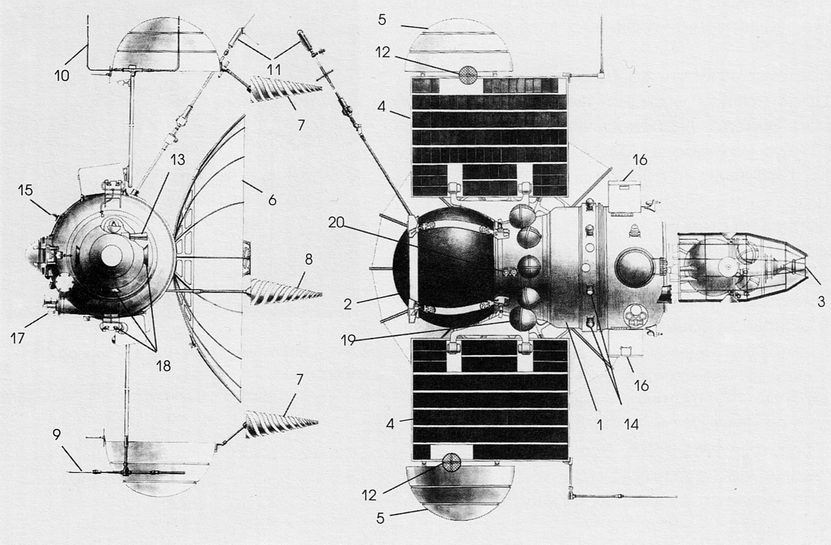
USSR Sputnik 19, 1962 Venera-type satellite
Source: NSSDCA Master Catalog
Sputnik 19, launched 25 August 1962, was a Venera-type spacecraft intended to make a landing on Venus. (Some reports indicate the target was Mars.) The SL-6/A-2-e launcher put the spacecraft into Earth orbit, but the escape stage failed (the motor burned for only 45 seconds of the planned 240 seconds) and the probe remained in geocentric orbit for three days, until the orbit decayed on August 28 and it re-entered Earth's atmosphere.
ref: nssdc.gsfc.nasa.gov
1964 13:43:00 GMT
NASA launched Explorer 20 (IE-A) into orbit from Vandenburg, California, for ionospheric research.
ref: nssdc.gsfc.nasa.gov
1965
Born, Andrew J. Feustel PhD (at Lancaster, Pensylvania, USA), NASA astronaut (STS 125, STS 134, ISS 55/56; 225d 9.25h total time in spaceflight)

Astronaut Andrew Feustel, NASA photo (5 December 2007)
Source: Wikipedia (www.jsc.nasa.gov unavailable August 2019)
ref: en.wikipedia.org
1965 15:17:00 GMT
NASA launched the OSO C solar observatory from Cape Canaveral, Florida, but the satellite failed to reach orbit because of a premature third stage ignition failure.
ref: nssdc.gsfc.nasa.gov
1965 17:54:00 GMT
NASA and the USAF launched X-15A MIT Scan, Stability test mission # 144 in which Milt Thompson reached a maximum speed of 3604 mph (5800 kph, Mach 5.11), and achieved a maximum altitude of 214,100 ft (65.258 km, 40.549 mi).
ref: en.wikipedia.org
1966
Z. Pereyra discovered asteroid #1769 Carlostorres.
1966 17:15:32 GMT
NASA launched Apollo-Saturn 202, a successful flight test of a production Apollo Block I type spacecraft using a Saturn IB launch vehicle, to demonstrate structural integrity and compatibility, and for evaluation of heatshield performance.
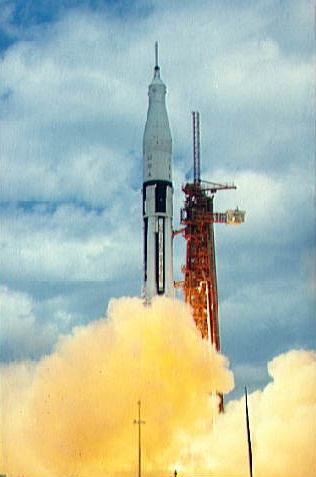
Apollo-Saturn 202 launch, NASA photo
Source: NSSDCA Master Catalog
The Apollo-Saturn 202 (AS-202) mission, launched 25 August 1966, was an unmanned suborbital flight to test the Saturn 1B launch vehicle and the Apollo Command and Service Modules. The objectives of the flight were to verify the structural integrity, launch loads, stage separation, and operation of subsystems of the Saturn 1B, and evaluate the Apollo spacecraft separations, emergency detection system, subsystems, heatshield at high re-entry velocity, and mission support facilities. All objectives were achieved.
The Saturn 1B and its payload consisting of the Apollo CSM-011 were launched from complex 34 of the eastern test range at Cape Canaveral. After both stages of the Saturn 1B completed their burns and separated, the service module propulsion engine burned for 3 minutes, 35 seconds to boost the spacecraft to a peak altitude of 1,128.6 km (701.25 mi). The rapid restart capability of the service module's engines was tested by firing three more times, the last separating the service module from the command module. The firings also accelerated the command module re-entry to greater than 8900 meters/sec (32,000 km/hr, 19,900 mph). Maximum temperature of the spacecraft exterior was calculated at about 1500 deg. C, temperature inside the cabin was 21 deg. C (70 F). The main parachutes deployed at 7250 meters altitude (4.5 mi, 23,800 ft) and the spacecraft splashed down at 18:49 UT, 93 minutes after liftoff. Splashdown occurred in the Pacific Ocean at 16.11 N, 168.97 E, roughly 800 km (500 mi) SE of Wake Island and 370 km (230 mi) from target. The capsule was recovered by the aircraft carrier USS Hornet at 03:17 UT on 26 August.
ref: nssdc.gsfc.nasa.gov
1966 17:49:00 GMT
NASA/USAF launched X-15A HS/MuMet/Gas Tech/Meteor/Aeronomy mission # 169. John McKay flew 3543 mph (5702 kph, Mach 5.11), reached 257,500 ft (78.486 km, 48.769 mi), collected micrometeorites, extraterrestrial dust, failed by re-entry inertial malfunction.
ref: en.wikipedia.org
1967 20:27:00 GMT
NASA and the USAF launched X-15A Guid/HT/BLN test mission # 187 in which Michael Adams reached a maximum speed of 3115 mph (5013 kph, Mach 4.63), and a maximum altitude of 84,400 ft (25.725 km, 15.985 mi).
ref: en.wikipedia.org
1976
Harvard College discovered asteroid #2221 Chilton.
1977 23:50:00 GMT
The Italian experimental spin stabilized commsat SIRIO-A was launched from Cape Canaveral and positioned in geosynchronous orbit over the Atlantic at 15 deg W 1977-1981; at 25 deg W 1981-1983; and over the Indian Ocean 65 deg E 1983-1985.
ref: nssdc.gsfc.nasa.gov
1981
Before its closest approach to the planet, NASA's Voyager 2 took photos of Saturn's moon Titan.
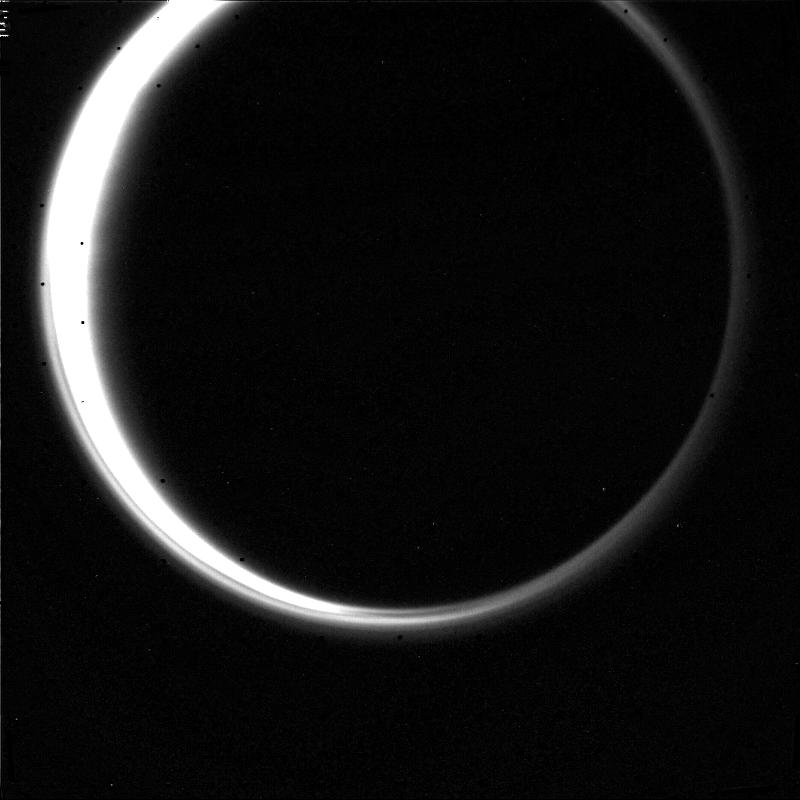
Voyager 2 narrow-angle camera image of Titan, Image ID PIA02290
Source: NASA JPL PhotoJournal
The Voyager 2 spacecraft, originally planned as Mariner 12 of the Mariner program, was launched on 20 August 1977 on a mission to explore the outer planets of the solar system. It is identical to its sister Voyager program craft, Voyager 1. Voyager 2 followed a somewhat different trajectory during its Saturn encounter, however, bypassing a close encounter with Titan in favor of taking advantage of a gravitational slingshot to travel on to Uranus and Neptune. It became the first probe to visit those two planets.
Voyager 2 was launched from Cape Canaveral, Florida aboard a Titan-Centaur rocket. The closest approach to Jupiter occurred on 9 July 1979. On 25 August 1981, Voyager 2 took pictures of Saturn's moon Titan showing the structure of the moon's atmosphere, and it flew past Saturn at a distance of 63,000 miles (100,000 km). Its closest approach to Uranus was on 24 January 1986, and its closest approach to Neptune occurred on 25 August 1989, after a 12 year, 4 billion mile journey, when it flew over the planet's cloud tops and those of its moon Triton, sending back photographs of 'swamps' from a distance of 5000 km. Voyager 2 imagery returned on 22 August 1989 confirmed the rings around Neptune are complete, although they are much more faint than those of Saturn.
On 5 November 2018, As Voyager 2 probe left the heliosphere, its CRS (Cosmic Ray Subsystem) recorded an abrupt change in particle energies.
Voyager 2 is expected to keep transmitting into the 2030s.
Voyager 2 carries with it a golden record (Voyager Golden Record) that contains pictures and sounds of Earth, along with symbolic directions for playing the record. The contents of this record were selected by a committee chaired by Carl Sagan.
As of 24 August 2003, Voyager 2 was at a distance of 10.6 billion kilometers (71 AU) and was escaping the solar system, diving below the ecliptic plane at an angle of about 48 degrees and at a speed of about 3.3 AU per year (ca. 15 km/s, 470 million kilometers (about 290 million miles) a year). On 8 July 2018 it was more than 17.65 billion km (10.97 billion miles, nearly 118 AU) from the Sun. (See Where Are The Voyagers Now? for distance, speed, and other interesting information.) It will be approximately 40,000 years before Voyager 2 approaches another planetary system.
See also NSSDCA Master Catalog
See also Wikipedia
ref: voyager.jpl.nasa.gov
1981
NASA's Voyager 2 flew past Saturn at a distance of 63,000 miles (100,000 km). During the encounter, it also photographed at least 7 of Saturn's small satellites.
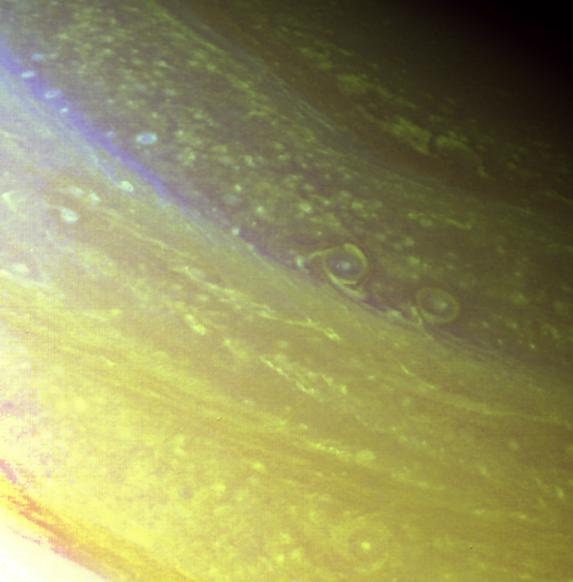
Saturn's north polar region from 633,000 km (393,000 mi)
Voyager 2 photo PIA02226 (25 August 1981)
Source: NASA JPL Photojournal
see above
ref: voyager.jpl.nasa.gov
1983 20:02:00 GMT
USSR launched the Raduga 13 communications satellite from Baikonur, which was positioned in geosynchronous orbit at 45 deg E.
ref: nssdc.gsfc.nasa.gov
1988
NASA's Challenger Center opened its classroom doors in Houston, Texas.
ref: er.jsc.nasa.gov
1988 07:12:00 GMT
The US Navy launched the Transit-O 25 and Transit-O 31 navigation satellites from Vandenburg, California.
ref: nssdc.gsfc.nasa.gov
1989 04:00:00 GMT
NASA's Voyager 2 was the first spacecraft to fly by Neptune, passing within 5,000 km of the cloud tops.
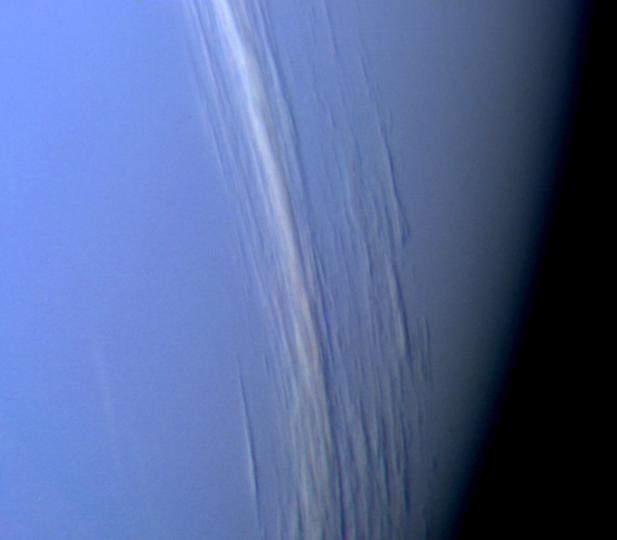
Photo 2 hours before close encounter shows vertical relief in Neptune's clouds
Voyager 2 photo PIA00058 (25 August 1989)
Source: NASA/JPL
see above
ref: voyager.jpl.nasa.gov
1991 08:40:00 GMT
Japan launched the Yuri 3B (BS-3B, Broadcasting Satellite-3B) TV communications satellite from Tanegashima, which was positioned in geosynchronous orbit at 110 deg E in 1991-1999.
ref: nssdc.gsfc.nasa.gov
1992
S. Otomo discovered asteroid #6975.
1994 14:25:12 GMT
Russia launched the Progress M-24 unmanned resupply vessel to Mir from Baikonur.
The unmanned resupply vessel Progress M-24 was launched 25 August 1994. It failed to dock automatically with Mir on 27 August. A second automatic docking attempt on 30 August also failed, and the Progress collided with the Kvant module. A third and final attempt, manually controlled by Mir commander Yuriy Malenchenko, was successful on 2 September at 13:30:28 GMT. Mir commander Malenchenko and flight engineer Talgat Musabaev made a spacewalk on 9 September to inspect the damage to the Kvant module made when the Progress collided with Kvant. Progress M-24 undocked on 4 October 1994 18:55:52 GMT, leaving the rear docking port free for Soyuz TM-20. It was destroyed in reentry over the Pacific at 38.4 deg S, 137.4 deg W,on 4 October 1994 22:43:00 GMT. Total free-flight time 8.12 days. Total docked time 32.23 days.
ref: nssdc.gsfc.nasa.gov
1997 14:39:00 GMT
NASA launched the ACE (Advanced Composition Explorer, Explorer 71) spacecraft, built by the Applied Physics Lab at Johns Hopkins University, which was placed at the Earth-Sun L1 point.
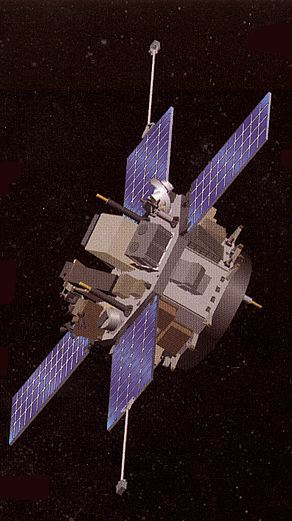
ACE (Advanced Composition Explorer, Explorer 71) spacecraft, NASA artwork
Source: NSSDCA Master Catalog
The objective of the Advanced Composition Explorer (ACE), launched 25 August 1997, was to collect observations of particles of solar, interplanetary, interstellar, and galactic origins, spanning the energy range from that of KeV solar wind ions to galactic cosmic ray nuclei up to 600 MeV/nucleon. Definitive studies were to be made of the abundances of essentially all isotopes from H to Zn (Z = 1-30), with exploratory isotope studies extending to Zr (Z = 40). The ACE payload included six high resolution spectrometers, each designed to provide the optimum charge, mass, or charge-state resolution in its particular energy range. Each spectrometer had a geometry factor optimized for the expected flux levels, so as to provide a collecting power greater by a factor of 10-1000 times that of previous or planned experiments. The payload also included three additional instruments of standard design to monitor energetic electrons, H and He ions, and a magnetometer. The ACE spacecraft was based on the design of the Charge Composition Explorer, built at JHU/APL for the Active Magnetospheric Particle Tracer Explorer (AMPTE) program. The spacecraft spin axis was pointed towards the Sun to within +/- 20 degrees, and it occupied a halo orbit about the L1 Earth-Sun libration point. Powered by solar cells, the spacecraft had a design life of at least five years, and it returned data in daily tape recorder dumps, received through NASA JPL's Deep Space Network and initially processed at NASA-GSFC. The average data telemetry rate was 6.7 Kbs.
ref: nssdc.gsfc.nasa.gov
1998 05:23:00 GMT
Soyuz TM-27 undocked from Mir at 02:05 GMT, with Musabayev, Budarin and Baturin aboard. The cosmonauts then landed near Arkalyk in Kazakstan.
ref: nssdc.gsfc.nasa.gov
1998 23:07:00 GMT
The Singapore-Taiwan-1 (ST-1) Matra Marconi Space Eurostar 2000 class satellite was launched from Kourou to provide communications for Singapore Telecom and Chunghwa Telecom of Taiwan, and positioned in geosynchronous orbit at 88 deg E 1998-1999.
ref: nssdc.gsfc.nasa.gov
2001
Died, Madge Adam, English solar astronomer internationally known for her work on the nature of sunspots and on their magnetic fields
ref: en.wikipedia.org
2003 05:35:00 GMT
NASA launched the Spitzer Space Telescope (formerly SIRTF, the Space Infrared Telescope Facility), the final element in NASA's Great Observatories Program.
The Spitzer Space Telescope (formerly SIRTF, the Space Infrared Telescope Facility) is a 0.85-meter telescope with three cryogenically cooled instruments, operating in the 3 - 180 micron range. The observatory is the final element in NASA's Great Observatories Program. The science capabilities include imaging/photometry at 3 - 180 microns, spectroscopy at 5 - 40 microns, and spectrophotometry at 50 - 100 microns. Spitzer will study a wide variety of astronomical phenomena, extending from our Solar System to the distant reaches of the early Universe.
SIRTF was launched by the second Delta II Heavy on 25 August 2003. The second stage entered a 166 x 167 km x 31.5 deg Earth parking orbit, and after about 33 minutes of coast, passing south of Madagascar, restarted at 0613 UTC to enter a hyperbolic orbit with a perigee of 170 km, an eccentricity of 1.0061, and a velocity of 11.05 km/s. This placed it in a solar orbit of 0.996 x 1.019 AU x 1.14 deg with a year about 4 days longer than Earth's: Spitzer has an Earth-trailing heliocentric orbit.
The spacecraft consists of an octagonal bus structure, and a solar array to power the science instruments. The pointing control subsystem employs a celestial-inertial, three-axis stabilized control system.
The Spitzer telescope is a lightweight reflector of Ritchey-Chretien design. The telescope has an 85 cm diameter aperture. The instruments selected include: 1) a four-channel infrared array camera imaging at 3.6, 4.5, 5.8, and 8 microns; 2) an imaging photometer, with three detector arrays imaging at 24, 70, and 160 microns (one array will also take low-resolution spectra at 50 - 100 microns); 3) a spectrograph providing high- and low-resolution spectroscopy at mid-infrared wavelengths (5 - 40 microns).
Spitzer depleted its cryogenic cooling supplies on 15 May 2009. As of 25 August 2015, Spitzer's "warm" mission with instruments at 28K is continuing as investigators from around the world use the facility to study the cosmos. The 3.6 and 4.5 micron cameras are still working at peak performance in the near- to mid-infrared portion of the spectrum. Astronomers use the Infrared Array Camera (IRAC) to study everything from comets and asteroids in our solar system, planets orbiting other stars, to the most distant galaxies in the Universe.
See also NASA's Spitzer Final Voyage page which tells its story, showcases new science and highlights its most outstanding achievements during the 16 years it was active in space.
ref: nssdc.gsfc.nasa.gov
ref: www.spitzer.caltech.edu
2012
Died, Neil A. Armstrong, X-15 pilot, NASA astronaut (Gemini 8, Apollo 11; nearly 8d 14h total time in spaceflight), member of first crew to dock in space, first person to step onto the Moon
Neil Alden Armstrong (5 August 1930 - 25 August 2012) was the first human in known recorded history to walk on the surface of another planetary body, stepping onto the surface of the Moon at 0256 GMT on 21 July 1969 during the Apollo 11 mission. He was also a member of the crew of the first spaceship to dock in space (Gemini 8), piloted 11 X-15 flights, and a test pilot with an extensive record before being selected as an astronaut in 1962.
ref: history.nasa.gov
2012
NASA's Voyager 1 probe crossed the heliopause, the boundary between the end of the Sun's magnetic influence and the beginning of interstellar space.
Voyager 1 spacecraft is an unmanned probe of the outer solar system, launched by NASA aboard a Titan-Centaur rocket on 5 September 1977 from Cape Canaveral. Its trajectory took Voyager 1 past Jupiter, and Saturn. It is now (2021) the most distant man-made object, and in 1998 was expected to keep transmitting valuable data at least until 2020. As of 12 November 2021, four of its ten instruments were still operating. Communications will be maintained until the Voyagers' power sources can no longer supply enough electrical energy to power critical subsystems. Voyager 1 is leaving the solar system, rising above the ecliptic plane at an angle of about 35 degrees, traveling at a rate of about 520 million kilometers (about 320 million miles) a year, and entered interstellar space on 25 August 2012.
Originally scheduled to launch twelve days after Voyager 2, Voyager 1's launch was delayed twice to prevent occurrence of problems which Voyager 2 experienced after launch. When Voyager 1's launch finally happened, it was termed "flawless and accurate." Although launched sixteen days after Voyager 2, Voyager 1's trajectory was the quicker one to Jupiter. On 15 December 1977, while both spacecraft were in the asteroid belt, Voyager 1 surpassed Voyager 2's distance from the Sun. Both prior to and after planetary encounters observations were made of the interplanetary medium. Some 18,000 images of Jupiter and its satellites were taken by Voyager 1. In addition, roughly 16,000 images of Saturn, its rings and satellites were obtained.
Voyager 1 began photographing Jupiter in January 1979, and made its closest approach to on 5 March 1979, at a distance of 349,000 kilometers (217,000 miles) from the center of the planet. It finished photographing the planet in April. Voyager 1's Saturn flyby occurred in November 1980, with the closest approach on 12 November when it came within 124,000 kilometers (77,000 miles) of the planet's cloud-tops. The craft detected complex structures in Saturn's rings, and studied the atmospheres of Saturn and Titan. Its trajectory, designed to allow close study of Titan, took it out of the plane of the ecliptic, thus ending its planetary science mission.
After its encounter with Saturn, Voyager 1 remained relatively quiescent, continuing to make in situ observations of the interplanetary environment and UV observations of stars. After nearly nine years of dormancy, Voyager 1's cameras were once again turned on to take a series of pictures. On 14 February 1990, Voyager 1 looked back from whence it came and took the first "family portrait" of the solar system, a mosaic of 60 frames of the Sun and six of the planets (Venus, Earth, Jupiter, Saturn, Uranus, and Neptune) as seen from "outside" the solar system. After this final look back, the cameras on Voyager 1 were once again turned off.
Voyager has mounted to one of the sides of the bus a 12-inch gold-plated copper disk. The disk has recorded on it sounds and images of Earth designed to portray the diversity of life and culture on the planet. Each disk is encased in a protective aluminum jacket along with a cartridge and a needle. Instructions explaining from where the spacecraft originated and how to play the disk are engraved onto the jacket. Electroplated onto a 2 cm area on the cover is also an ultra-pure source of uranium-238 (with a radioactivity of about 0.26 nanocuries and a half-life of 4.51 billion years), allowing the determination of the elapsed time since launch by measuring the amount of daughter elements to remaining U238. The 115 images on the disk were encoded in analog form. The sound selections (including greetings in 55 languages, 35 sounds, natural and man-made, and portions of 27 musical pieces) are designed for playback at 1000 rpm. The Voyagers were not the first spacecraft designed with such messages to the future. Pioneers 10 and 11, LAGEOS, and the Apollo landers also included plaques with a similar intent, though not quite so ambitious.
All of the experiments have produced useful data, except for the photopolarimeter which failed to operate.
ref: voyager.jpl.nasa.gov
ref: voyager.jpl.nasa.gov
We are going to run out of oil!
Visit SpacePowerNow.org
to help fix the problem.
SpacePowerNow.org - For Human Survival
Please help support our efforts by shopping from our sponsors.
This newsletter and its contents are Copyright © 2006-2025 by The L5 Development Group. All rights reserved. - Publication, in part or in whole, requires previous written permission. - Academic or personal-use citations must refer to http://L5Development.com as their source. Thank you for your cooperation.
Space History Department
Resources
The L5 Development Group Home Page
The L5 Development Group Keyword Access System
Space History for August 25 /
Webmaster /
Script last modified August 23, 2018 @ 6:05 am
Copyright © 2006-2025 by The L5 Development Group. All rights reserved.
Hosted by FKEinternet






